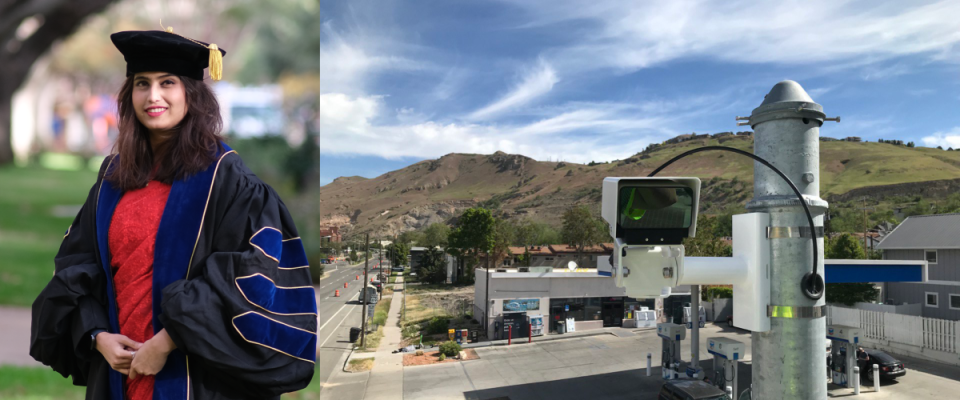NITC Alumni Spotlight: Farzana Chowdhury, University of Texas at Arlington

Farzana Rahman Chowdhury is an associate consultant traffic engineer at WSP USA. She earned a master’s in transportation engineering from Mississippi State University in 2019 and a Ph.D. in civil engineering from the University of Texas at Arlington in summer 2022. Her research focuses on network modeling, traffic engineering, and transportation planning.
Connect with Farzana on LinkedIn
As a PhD student, you worked with Dr. Li on the NITC project "Pedestrian Behavior Study to Advance Pedestrian Safety in Smart Transportation Systems Using Innovative LIDAR Sensors," Tell us about that work?
I worked with Dr. Li on this project as part of my doctoral dissertation. As a part of the project, we installed an industry-level LIDAR sensor at 2 separate intersections in the Dallas-Fort Worth (DFW) region with significant amount of pedestrian traffic. Although only one has voice-assisted infrastructure to help pedestrians cross. This aim of this study was to gather exact pedestrian data using LIDAR sensors and evaluate pedestrian behaviors such perception-reaction time, waiting time, and crossing time at crossings in conjunction with traffic signal statuses.
As an outcome of the research, we proposed a dynamic flash yellow arrow mechanism based on LiDAR tracking system to fully protect concurrent crossing pedestrians from permissive left-turn vehicles. The project's outcomes were highly intriguing. The LIDAR sensor not only accurately catches real-time pedestrian behavior and gave pedestrian volume data, but it also provides a highly flexible mechanism to separate the left-turn vehicles from concurrent pedestrians while maximizing the remaining permissive left-turn capacities.
You also worked on a second NITC project, "Using Social Network Analysis To Optimize Access To Culturally Responsive And Affordable Transportation For Older (Im)Migrants" with Rebecca Mauldin, Stephen Mattingly and Rupal Parekh. What was your work on that project like?
The health, social engagement, and welfare of older persons depend on having access to reliable transportation, but older immigrants in the United States encounter a few transportation-related challenges. These include increased vulnerability to physical impairments that make using many modes of transportation more challenging, increased likelihood of economic insecurity that may limit access to resources for transportation like private automobile ownership, and linguistic and cultural differences between service providers and older immigrant service users. An added burden for the transportation providers may result from elder immigrants' tendency to rely on others in their social networks for private transportation. Besides these generalizations, there is significant variability throughout many parameters among immigrant populations.
I also got an opportunity to work with Dr. Mauldin, Dr. Mattingly and Dr Parekh on a project where we conducted social network analysis to optimize access to affordable transportation for older adults. This study helps to broaden the knowledge base of older Vietnamese adults and the drivers they use in the transportation industry. It is, to our knowledge, the first study to examine the geographic burden of delivering rides using ride provision activity spaces. It is important to provide transportation policy makers with information they need to support private transportation companies in service areas with a dearth of public transportation or paratransit options or to provide older immigrants with transportation services that are culturally appropriate.
Now that you've graduated, you are working as an associate consultant for WSP USA. What types of projects are you doing in your day-to-day work?
As a young Associate Consultant for WSP, USA, I was exposed to numerous important transport infrastructure projects. I carried out traffic simulation using Vissim, traffic impact analysis using Synchro, and trip generation matrix development as a part of those projects. One of the key projects I'm working on is a Bus Rapid Transit (BRT) project for a major Texas city. In addition, I'm involved in a feasibility study for a large-scale road project in Texas.
How did support from the National Institute for Transportation and Communities (NITC) impact your educational or career journey?
My overall journey so far has been significantly influenced by NITC. I received the training and confidence I needed at NITC to become a successful transportation engineer. I had the chance to work on two important NITC projects, where I recognized some of the core issues with the current transportation system and created special solutions for each of them. The resources and technologies I used for those projects, like ArcGIS, PTV Vissim, and Synchro, are today assisting me in overcoming any professional problem.
The National Institute for Transportation and Communities (NITC) is one of seven U.S. Department of Transportation national university transportation centers. NITC is a program of the Transportation Research and Education Center (TREC) at Portland State University. This PSU-led research partnership also includes the Oregon Institute of Technology, University of Arizona, University of Oregon, University of Texas at Arlington and University of Utah. We pursue our theme — improving mobility of people and goods to build strong communities — through research, education and technology transfer.
